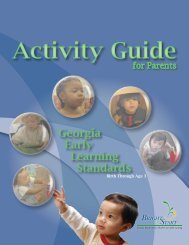Georgia's Pre-K Program - FPG Child Development Institute ...
Georgia's Pre-K Program - FPG Child Development Institute ...
Georgia's Pre-K Program - FPG Child Development Institute ...
Create successful ePaper yourself
Turn your PDF publications into a flip-book with our unique Google optimized e-Paper software.
Georgia Study of Early Care and Education: Findings from Georgia’s <strong>Pre</strong>-K <strong>Program</strong><br />
The Classroom Assessment Scoring System (CLASS) 13 provides an assessment of the<br />
quality of teacher-child interactions. Its ten dimensions are organized into three<br />
domains. The Emotional Support domain includes positive climate, negative climate,<br />
teacher sensitivity, and regard for student perspectives. The Classroom Organization<br />
domain includes behavior management, productivity, and instructional learning<br />
formats. The Instructional Support domain includes concept development, quality of<br />
feedback, and language modeling.<br />
Each dimension is rated from 1 to 7 with 1 or 2 indicating the classroom is “low” on<br />
that dimension; 3, 4, or 5 indicating that the classroom is in the “mid-range;” and 6 or<br />
7 indicating the classroom is “high” on that dimension. The observer rated the pre-k<br />
classroom and the teacher on 10 dimensions roughly every 30 minutes throughout the<br />
observation day. Six 30-minute observation cycles were completed in each room.<br />
The Language and Literacy Environment Subscale of the Early Language and Literacy<br />
Classroom Observation: <strong>Pre</strong>-K (ELLCO) 14 is an observational instrument for examining<br />
support for children’s language and literacy development. The ELLCO is designed<br />
for use in classrooms serving 3- to 5-year-old children. The Language and Literacy<br />
Environment subscale is comprised of Language Environment (e.g., opportunities<br />
for extended conversations, vocabulary development); Books and Book Reading (e.g.,<br />
organization of the book area, use of books across contient areas, quality and frequency<br />
of book reading); and Print and Early Writing (e.g., opportunities that build awareness<br />
of print and purpose of writing, instructional strategies).<br />
Scores on the Language and Literacy subscale of the ELLCO can range from 1 to 5, with<br />
1 indicating “deficient” practice, 2 indicating “inadequate” practice, 3 indicating “basic”<br />
practice, 4 indicating “strong” practice, and 5 indicating “exemplary” practice.<br />
The Emerging Academic Snapshot (Snapshot) 15 is a measure of children’s involvement<br />
in classroom activities and interactions with peers and adults. The observer focuses<br />
on four randomly selected children in each classroom and then records information<br />
about their activity setting (e.g., free choice/center, whole group time, routine, meals),<br />
their engagement in pre-academic activities including literacy, math, social studies,<br />
science, aesthetics (e.g., art, music, drama), and motor activities, as well as how much<br />
time children spent interacting with adults. For this study, the observer watched the<br />
activities and behaviors of each child (generally two girls and two boys) for 20 seconds,<br />
once every four minutes. The observation period lasted from the beginning of class<br />
until nap time. On average, 234 observations (20 seconds each) were made in classes in<br />
centers and 231 observations were made in classes in schools. Observational data from<br />
the four children across the entire observation period were summarized to provide<br />
classroom-level data regarding how children spent their time.<br />
5
















